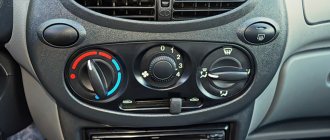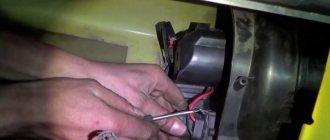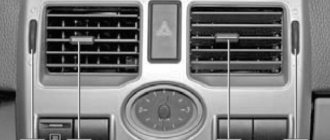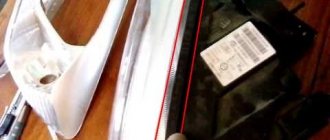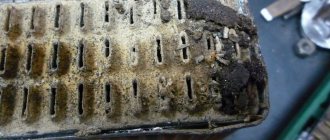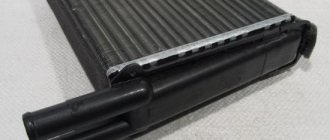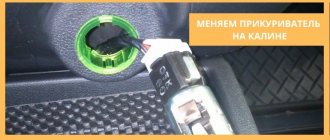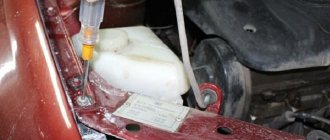Hello, dear readers of the blog Kak-kupit-auto.ru . Replacing the stove on Kalina is not an easy task, but that is exactly what we will talk about in this article. Kalina's stove is one of its main advantages. It heats well, and even in severe frost the interior warms up quite quickly. While Kalina is new, everything is going great, but soon Kalina may disappoint its owner. If the heater radiator starts to leak, then puddles of antifreeze will appear on the floor mats, and in the worst case, antifreeze can even flood the electronic engine control unit.
Replacing a stove radiator without removing the panel
you find an oily liquid in the area of the stove radiator replace the stove radiator of your viburnum and preferably do this as soon as possible, before the leak gets worse. The heater radiator in Kalina is located in the center console, just below the radio compartment, slightly to the right and above the gas pedal.
By removing the plastic cover, you can see the surface of the radiator and visually assess its condition. Look, on my Kalina after the eighth winter the heater radiator looked like this:
The standard Kalinovsky heater radiator is made from the same materials: plastic and aluminum. In winter, it experiences large temperature changes, which is why the radiator begins to leak, usually in the cold season. On my viburnum, the radiator of the stove began to leak already in the third year of its life, but it happened so slowly that I didn’t notice anything.
The antifreeze penetrated inside the ECU and oxidized the board, it shorted out, and the car stopped starting. Having installed a new ECU (price 5,000 rubles), I wrapped it in polyethylene (I should have done this on a new car). Another 5 years passed, the oxides at the end of the radiator became more and more noticeable, and last winter, the first drops of antifreeze fell on the carpet on the driver’s side:
I think that all this time the antifreeze was leaking very slowly from the radiator into the air duct, from where it managed to evaporate with the air flow. Later, having taken out the original radiator of Kalina’s stove, I discovered a green puddle under it:
So, when I saw drops of antifreeze, I realized that I could no longer put off repairing the stove . In the spring, I planned a mandatory replacement of the radiator of Kalina’s stove and, while waiting, I began to study the Internet in search of information.
How to change a radiator
The operation is very labor-intensive, for which the car service center will charge you a hefty sum. But there is another, slightly barbaric, but fast and widely practiced method. The work flow diagram is as follows:
- Drain the antifreeze, disconnect and remove the battery, and then disconnect the hoses from the heater pipes.
- Unscrew the nut located near the fittings in the engine compartment. It holds a steel plate that will interfere with the removal of the heater.
- Remove the gas pedal and pull out the steel brake pedal shaft. Unscrew the decorative panel and behind it the plastic panel covering the stove radiator.
- To remove it, cut an opening in the plastic frame that allows you to pull the radiator towards the driver.
- Install the new element and reassemble in the reverse order. The cut opening can be sealed with plastic and decorated in any suitable way.
When performing the operation, it is worth moving the controller located directly under the stove to another place. Antifreeze dripping from it can damage sensitive electronics. Also, with the radiator removed, it is easy to change a faulty heater valve or gear motor, because access to them will be open. The gearbox is a single unit with a damper position sensor and can also be changed entirely.
Kalina stove. Replacing the stove on Kalina
After taking half a break from the Internet, I realized that there is not enough information on this issue. All I was able to reliably find out is that replacing a stove radiator on a viburnum is not an easy task. Our respected designers designed the car in such a way that to replace the heater radiator it is necessary to disassemble almost half of the interior of the car:
Then I called the car service center and found out that I would have to pay 5-7 thousand rubles for the procedure for replacing Kalina’s stove. The amount alarmed me, but what seemed most unpleasant to me was the need to dismantle many elements of the interior, including the front panel. Somehow I didn’t want, as a result of non-factory assembly, to get new crickets or breakage of existing components, so I began to persistently look for alternative options for replacing the radiator without removing the front panel of the car .
I spent quite a long time studying information on the Internet and as a result I found out that:
- To install a new radiator, you need to remove the old one (this is understandable), but this can be done without removing the dashboard, you can only break off its long fittings from the old radiator, sticking out from the passenger compartment into the engine compartment
- But installing a new radiator without dismantling the dashboard is impossible. Installing a new radiator is hampered by its long fittings. You cannot shorten them on a new radiator - then you will not be able to put hoses on them from the engine compartment side. Look, the fittings don’t protrude too much into the engine compartment, especially the lower one:
Compare, on the left is the new radiator (with fittings), and on the right is the old one (without fittings):
What is the damper responsible for?
While the engine is running in the cooling system, the heated liquid moves through, while it heats the air passing through it. The volume of air passing through the radiator and outside it is controlled by the main heater damper. Depending on how the temperature control knob is located on the dashboard, the amount of incoming air will depend.
You can distribute air movement throughout the cabin by turning the handle that regulates the position of the damper. But there are cases when the damper jams and it is impossible to properly regulate the flow of heat into the Kalina’s cabin.
If the problem is only with the valve, then you can correct the situation quite simply by tightening its cable. If after these actions the situation has not changed for the better, then you need to conduct a visual diagnosis of the condition of the mechanism and perform a number of simple steps.
Dimensions of the standard radiator of the Lada Kalina stove
At one time, I was never able to find either the dimensions or a clear image of the radiator of the Kalina stove ; one might say, I had to select the radiator blindly, agreeing to return it if it didn’t fit. Therefore, I hasten to share this information with you, dear readers. I hope it will be useful, for example, if you decide to install a heater radiator from another car.
So, the dimensions of the Kalina stove radiator : 240 x 195 x 50 mm
You may also find the dimensions of the niche in which the Kalina heater radiator is installed useful: 54x198 mm. However, if you are planning to install a heater radiator from another car, keep in mind that the edges of this niche are strongly rounded:
Methods for replacing a stove radiator on Kalina
Now, dear readers, I will describe methods for replacing a stove radiator that I managed to find on the Internet. I managed to figure out four ways to install a stove radiator on Kalina , of which I chose the last one (then it seemed optimal to me).
- Removing the dashboard
- Shortening the radiator fittings
- Sawing out air ducts
- Gazelle stove
Let's look at each of the methods for replacing the Kalina stove and look at the pros and cons of each of them.
Removing the dashboard
This method of replacing the Kalina stove radiator is officially recommended by the manufacturer. According to this method, as planned by our designers, to replace the heater radiator , you must remove the dashboard - the front panel of the car. I immediately rejected this option for at least two reasons.
- Firstly , I don’t want to disassemble “half the car” to replace the stove, because during assembly, something may be assembled incorrectly, something may creak, and something may stop working altogether
- Secondly , I wouldn’t want anyone to do this on their own, and the service costs about 5-7 thousand rubles. – quite expensive and no guarantees))
Here you will find a detailed description of this barbaric procedure.
Sawing out air ducts
The second way to replace the stove on Kalina is to cut out part of the air duct,
then a new heater radiator is inserted,
and the sawn-off wall of the air duct is returned to its place using glue:
I rejected this method because it seemed to me the most barbaric and collective farm (after disassembling the panel, of course). On the other hand, it has its advantages:
- no need to remove the metal plate with rubber band
- no need to disassemble the brake pedal
- original pipes and radiator are used (everything fits perfectly)
This method can be quite effective, provided that you can restore the tightness of the sawn air ducts.
Shortening the radiator fittings
The third method is to shorten the fittings on the standard Kalinovsky stove radiator. Theoretically, it is possible to shorten the fittings of the original Kalinovsky radiator to such a length that it becomes possible to install it in a niche. Then you need to use longer hoses (for example, from the 2108 stove) and put them on shortened fittings directly inside the car.
At that moment, the only mention of the successful use of this technique seemed unconvincing to me, and I could not find any other evidence. When I imagined how I would assemble all this in the area of the carrion unit, this method did not seem very promising to me, however, now, having studied the location of the units, I think that next time I should try installing a standard radiator using this method.
I note that will most likely not be possible to use rubber seal therefore the tightness of the interior is reduced and this is the main disadvantage of this method, not counting the inconvenience of assembling the pipes on the radiator.
Stove from Gazelle or from Volga
The name of the method speaks for itself - the idea is to replace the standard radiator with a heater radiator from another car, for example, a Volga or Gazelle. Looking ahead, I will say: I do NOT recommend , a little later you will understand why.
The point of this method of replacing a stove radiator is that, instead of the standard one, you can put a stove radiator from a Gazelle or Volga in Kalina (it should fit in size), but its fittings have a different configuration, so they must be routed to the right - on the passenger side .
In order to bring out the fittings on the right, you need to make holes in the plastic wall under the glove compartment, and throw the hoses through the top - behind the dashboard, fortunately there is enough space there. Holes in the wall can be made using a soldering iron, but don’t worry about aesthetics - the hoses can only be seen from the height of the seat surface.
The advantage of this scheme is that to replace the radiator there is no need to disassemble anything under the hood, just drain off the excess antifreeze, and the rest of the work is done inside the car.
In my opinion, Kalina’s designers should have used exactly this scheme: position the heater radiator with the fittings to the right and make it come out towards the passenger, and on the left, on the contrary, close the compartment hermetically. In this case, to replace the radiator on the passenger side, there would be no need to disassemble two pedals, and under the hood you would only need to drain the excess antifreeze.
Here I found a detailed positive report on how the Volgov radiator is ideal for replacing the standard one on Kalina.
Reviews about the copper radiator were only positive, so I decided to install one for myself and started looking for a radiator. However, I was unable to find this copper miracle. Instead, I always came across these radiators, whose height exceeds the permissible height by more than a centimeter. By the way, the price of such a copper radiator is about 2 thousand rubles.
Having never found a copper radiator of a suitable size, I bought it for 650 rubles. Gazelle radiator made of plastic and aluminum and installed it on the viburnum. I won’t describe the installation process in detail, because... this path of development turned out to be a dead end. I’ll just give you a photo to compare sizes:
Please note: the Gazelle stove radiator (pictured on the right) is a centimeter smaller in width, and its fittings are thin - only 16 mm, while the Kalinovsky one is 18 and 20 mm. In addition, the fittings seemed too long to me, so I shortened them. As it turned out, this was impossible to do.
I used solid 1.5 meter hoses from the engine to the radiator so as not to create unnecessary resistance. The fittings on the engine have a diameter of 20 mm. I was unable to put an 18-gauge hose on them, so I used a reinforced hose with a diameter of 20 mm.
And so, a week after installing the Gazelle radiator, antifreeze began to drip from under the hoses on the stove radiator. After tightening the clamps, I discovered that the leak was only getting worse. Then I removed the hoses and realized that these fittings were so flimsy that under the pressure of the clamps they simply folded inward.
I had to buy another Gazelle radiator, but this time with more powerful fittings with a diameter of 18 mm. Strange, but this radiator was cheaper - only 600 rubles.
The second copy looked more serious, it had a reliable, solid appearance, the box bore the inscription “made in Germany,” but it was also about a centimeter smaller in width than Kalinov’s. In the summer, I shouldn’t have attached any importance to this, but with the arrival of winter it became clear: the tightness of the radiator plays a key role in the efficiency of the stove.
When installing the second radiator from the gazelle, I did not cut the fittings, put the hoses going to the engine on them (two reinforced hoses with a diameter of 20 mm, a length of 1.5) and secured each hose with two clamps. Subsequently, over six months of operation, no leaks arose here:
So, I drove with the second radiator from June to December, and with the onset of frost I realized that my stove was practically not heating. Now I understand that the heater radiator , so cold air under pressure from the fan, instead of passing through the radiator plates, rushed past, into the gap formed due to the insufficient width of the radiator.
In addition, when installing the heater radiator from a gazelle, I did not sufficiently seal the radiator with foam rubber. Look how my heater radiator from a gazelle. This is an example of what not to do, but you will see how to seal a stove radiator a little later.
Some useful tips
Any car owner who has to carry out work to replace or repair a heating system radiator wonders about the reason for the failure of the unit
It is important to consider 2 factors that allow you to extend the continuous operation of the device
- It is necessary to timely replace the system air filter. A clogged radiator is more likely to fail. There is a set period for periodic replacement, but you can do it more often, for example, change the filter after winter use and at the end of the summer season.
- Replace the coolant in a timely manner. This operation should be carried out every 60 thousand kilometers. Accumulating wear products destroy the light metal of the radiator, depriving it of its tightness. Many car owners believe that by periodically adding antifreeze to the system, they will not have to change the unit. However, corrosion products continue to accumulate, having a detrimental effect not only on the heater radiator, but also on the engine as a whole.
A pressing issue is the use of high-quality antifreeze. You should buy it from trusted sellers and do not use water in the cooling system.
The operation of any vehicle involves not only the maintenance and repair of parts and systems that ensure its movement. Assistive devices play an important role in the operation of a car. And if the radiator of the cooling system fails, not only the microclimate in the car is disrupted, but it also becomes unsafe to drive due to fogging of the windows.
In winter, my pepelats is not as warm as it should be. At the same time, the fan works normally, judging by the air flow. The thermostat is most likely working, since the engine temperature reaches one hundred and ten, and the radiator fan turns on at the same time. The heater radiator could not be clogged in three years, I think. What else can you sin on? Air lock? I have never had gurgling sounds anywhere.
I decided to feel the plastic lever of the heater damper. Sitting on the driver’s seat, I crouched down and grabbed this lever with my right hand. He extended his left hand to the base of the windshield to feel the temperature of the air flow from the blower slots. At the same time, my ear ended up near the deflectors above my beard. My observation: When I pressed the lever, the sound in the deflectors changed. And the air became warmer. Not that the air became fiery. Of course not. But my hand felt the difference.
Now we need to figure out how to solve this problem. I don’t like the options that I saw on the drive, when they were making rubber bands and springs. The “shit and sticks” method is, of course, good... But I want to do it once and forget. Maybe , does anyone have any ideas? Or has anyone already gone through this stage?
Yesterday after work I used the first spring I found.
What if you turn the stock radiator upside down?
So, friends, with the arrival of cold weather, I noticed that the stove was heating rather weakly, and at an outside temperature of -10°C, the windows thawed only after 30-40 minutes of intense traffic. It was impossible to drive like this, and during the next thaw I decided to start the third (I hope the last) replacement of the stove radiator .
By this time, I had come to the understanding that enough experiments were enough and I still needed to install the original heater radiator from Kalina , ideal in size and shape. Moreover, before installation, it must be carefully sealed with foam rubber so that the air from the fan passes through the radiator fins and not past it.
At that moment, I didn’t yet know how I was going to install a standard radiator, but I still didn’t intend to cut out the air ducts or disassemble the dashboard. It seemed to me that there must be some simpler and more logical way to install a standard radiator. Having purchased new pipes and a heater radiator from Kalina in advance (650 rubles), I removed the installed radiator from the gazelle and tried to install the standard radiator in its place. As one would expect, the fittings rested against the partition of the engine compartment, so the standard radiator could not be pushed into the niche even half its length.
After dismantling the radiator from the gazelle, I began to think about how to install a standard radiator without breaking anything. I twisted and turned the radiator, placed it this way and that way, and suddenly an idea came to my mind: what if we turn the heater radiator with the fittings not towards the engine, but towards the driver?
The idea, although bold, was viable, so after 4 hours hot air was already blowing from the heating system deflectors. Now, let's look at the whole process of replacing the stove on Kalina from start to finish using the radiator reverse method . Let's start by making a list of everything we'll need.
Checking heating system elements
If the heater on the Lada Kalina does not work - it blows cold air - it is better to look for the reason, starting with the simplest thing. You should not immediately disassemble complex components. Typically, most problems arise from minor problems.
temperature sensor
If only hot or, conversely, only cold air blows from the air duct nozzles, regardless of the position of the damper, the cause of the malfunction is the interior temperature sensor. It is located in the ceiling, in the lampshade. The problem is solved by replacing the sensor.
Heating fan
If switching modes and air flow speed does not produce anything (a whistle or crackling sound is heard, the fan begins to make noise), the malfunction is related to the electric fan. To check this, you need to do the following:
- Set the temperature control knob to the extreme blue zone position.
- After that, use the switch to change the fan speeds from first to fourth.
The air flow should become stronger as speed increases. If this does not happen, then the fan is faulty. If it works, but not in all modes, or the speed changes disproportionately, then the cause of the breakdown is a failed auxiliary resistor. The source of the problem may be a blown fuse F5 in the mounting block due to an open circuit in the power supply.
Heater damper
To check the heater damper on the Lada Kalina, you need to set the temperature control knob to the extreme position in the blue zone, and the fan speed switch to “maximum”. Then you need to turn the damper control knob and at the same time monitor how the direction of air mass flow changes. If nothing happens, this indicates a malfunction of the damper regulator or the damper is stuck in one position (the traction cable has come off).
Tools and materials for repairing the Kalina stove
Necessarily:
- Two screwdrivers: Phillips and flat (for unscrewing clamps)
- Ratchet wrench
- Heads 7 and 8 (for unscrewing clamps)
- Heads for 10, 13
- Long head 10 (5 cm long)
- Keys for 10, 13
- Long pliers or pliers (to break out the old radiator fittings)
- Metal file (carefully saw off the fittings of the new radiator)
- Sharp knife (for cutting foam rubber)
- Standard heater radiator Kalina 11183
- 3 meters of reinforced hose, internal diameter 20 mm
- Two corners made of tubes (D=18-20 mm, size 50x50 mm)
- Foam rubber 5 and 15 mm thick
Desirable:
- Lighting: carrying lamp or lantern
- A piece of coolant drain hose + adapter tube
- Needle-nose pliers (for unscrewing hard-to-reach clamps)
I draw your attention, dear readers, that for repairs, two tubular angles with a diameter of 18-20 mm (according to the hose diameter) measuring 50x50 mm , which will turn the fluid flow from the fittings upward (they are on the right in the photo):
You can try to do without these corners , but in this case the hoses will be very bent and it is possible that antifreeze will not be able to circulate freely through them. In addition, the load inevitably increases in places of fractures, therefore the risk of leaks increases, which are extremely undesirable in the car interior.
I bought the corners for 50 rubles. in the GAZ spare parts store. At the same time I grabbed a handful of clamps of the appropriate size
Replacing the stove on Kalina using the radiator reverse method
So, let's begin. We park the car so that on the left you can open the driver's door and carry out work in the area of the pedal assembly. Open the hood, remove the air filter and air duct .
It is recommended to plug the holes in the air filter and in the throttle with a clean cloth so that during operation dust, dirt and foreign objects that could further damage the engine do not get inside.
We remove the battery and the platform under it (keys 10, 13, ratchet wrench with a head 13).
To completely remove the platform, unscrew the hard-to-reach nut with a 10mm head, which secures two pipelines to the platform. These hoses have to be unscrewed every time you remove the platform under the battery, so I connected them together and don’t screw them to the platform anymore, because they won’t go anywhere anyway
Next we need to drain the antifreeze , but this can be done in at least two ways .
How to drain antifreeze on Kalina?
To avoid burns, work with coolant only when the engine is cool.
There are two ways to drain antifreeze:
- 1) You can unscrew the drain plug on the lower right side of the engine radiator and open the expansion tank cap. If you drain using the classic method, I recommend that you replace the standard radiator cap with this tuning version, which is sold in the store for 15 rubles. The slots for the screwdriver on the standard plug (pictured on the left) quickly break, you have to look for it by touch - it does not protrude from the radiator, and the tuning plug (pictured on the right) is clearly visible and can be easily unscrewed by hand. I recommend all potassium growers to install such a plug!
- 2) The second method of draining antifreeze is to drain only that part of the antifreeze that is in the heater radiator (1-2 liters). In this case, all the drained coolant will be collected in a canister and not a drop will be spilled, and the rest of the liquid will remain in its place in the system.
The technique is as follows: remove the hose from the heating of the throttle assembly:
Coolant will be drained from this hose, so it must be extended with another hose , and the free end placed in a canister where the drained antifreeze will be collected. As an adapter , I use a high 10 head, fortunately it has a through hole, and, in fact, it is a tube.
Next, we clamp our finger on the heating fitting of the throttle assembly (from which the hose is removed) and blow into the expansion tank . The pressure in the system increases and antifreeze rushes through the hose directly into the canister. When air comes out of the hose, it means that most of the antifreeze has already left the stove.
Blowing into the expansion tank is not an amateur activity, so some would prefer to drain the coolant through the radiator cap, but I made a simple device that allows me to pump air into the system using a compressor. Having disassembled the old cap from the expansion tank, I drilled a hole in it and inserted a nipple from the car inner tube from the inside:
Now we pump the reservoir with a pump or compressor and the coolant drains itself.
Malfunctions of the Kalina heating system
The most common malfunctions of the stove are that the air flow is weak, only cold air comes in or not at all. Among the reasons why the stove on the Lada Kalina does not heat:
- Wear of the engine cooling system pipes. Antifreeze leakage due to worn hoses leads to a decrease in its level in the system, and therefore to insufficient heating of the heater radiator.
- The stove valve is out of order. This malfunction can be determined by the puddles of coolant that appear on the floor, under the front mats.
- The heating control unit is faulty. First, you should check the power supply from the on-board network. If it arrives, there is a problem in the air conditioning system. It is better to entrust unit repair to specialists.
- Wiring problems. There is no voltage supplied to the heating control unit. To check this, you will have to “ring” all sections of the chain.
- The additional resistor used to control the electric fan is faulty.
- The heater regulator is broken. In this case, it will be impossible to set a comfortable air temperature in the cabin.
- The radiator is faulty. One of the most common problems is that the Lada Kalina stove does not heat well. In the event of a breakdown, coolant leaks are typical. The part cannot be repaired.
If the problem is not heating, the cause is a malfunction of some part of the cooling system. These two systems are interconnected, and problems with one negatively affect the other.
Dismantling the old heater radiator Lada Kalina
So, when the antifreeze is drained, remove the pipes supplying the stove from the upper and lower fittings of the engine.
The diameters of the lower and upper pipes on the engine side are 20 mm.
The diameter of both fittings excluding the sides is also 20 mm.
If you pay attention to the protruding sides on fittings , it becomes clear why it is very difficult to put a reinforced hose with a diameter of 18 mm . In any case, I was unable to do this. But the 20th hose fit perfectly, so I recommend that you use a hose with a diameter of 20 mm .
Looking ahead, I will say that a reinforced hose at a regular hardware store at a price of 60 rubles per meter. Two pieces of 1.5 meters each are enough to spare even for installing a heater radiator from a Gazelle, and for installing an inverted standard radiator, 1 meter in each direction will be enough. It’s better to buy a hose with a diameter of 20 mm (it’s on the right in the photo), because... it is easier to put it on the fittings on the engine side.
I had the 20th hose installed with a radiator from a Gazelle, but when replaced with a standard radiator, these hoses went to waste, and their place was taken by a hose with a diameter of 18 mm (since it was in stock). However, to connect it to the engine, I made adapters, but more on that below.
Next we need to get to the heater radiator and remove the old pipes from them. This is not easy to do - the fittings are in a hard-to-reach place , so I unscrewed the left link from the steering rack (in the photo it lies on top of the steering rack), although you may be able to do without this operation. The clamps on the fittings were heavily oxidized , and there was simply no room for working with a wrench, so I was able to unscrew the clamps only with long, thin-nose pliers :
When the hoses are removed, unscrew the nut, which is located on a long pin, to the left of the heater radiator :
Looking ahead, I will say that this pin a steel plate to the engine shield , on which a rubber gasket , ensuring the tightness of the interior. Here is a photo of it from the pedal side:
The lower pipe is easier to unscrew:
The pipes have been removed. The upper hose is longer (in the photo it is below)
Now we move into the interior and unscrew the three screws securing the heater radiator , as well as the shiny steel plate :
Next, remove the gas pedal from the bracket. You can disconnect it from the throttle cable, but I didn’t do this - I just moved it to the side.
At the same time, we’ll immediately pull out the brake pedal - this will provide us with enough space to remove the radiator from its niche. You need to disassemble the brake pedal if you prefer to easily get out the old radiator without sawing it with a hacksaw, as is done here. To do this, remove the locking plate and take out the cotter pin that secures the pedal the rod :
Next you need to remove the brake pressure sensor . the two terminals from the sensor , loosen the plastic nut by 19 and unscrew the sensor from its thread.
Hint : if you mark with a marker the place on the thread where the nut was located, then during assembly, setting up the brake light will take you much less time.
When the pedal is disconnected and sensor is removed, the pedal moves freely in the longitudinal direction. We move the pedal back (towards ourselves) and to the left. This will be prevented by the stop on the pedals , into which the dismantled sensor previously rested. The stop may even bend slightly - this is not a big deal (during reassembly we will return it to its original position), the main thing now is to pull the pedal towards you.
Next, raise the Shumka and use a 10 mm socket to unscrew the three bolts securing the gas pedal bracket to the body.
We remove the bracket, turn the excess noise to the side and you can try to remove the heater radiator from its socket. If you succeed, then this whole article was written in vain, because in the same way you can put a new radiator in place)). If a miracle did not happen, and you were prevented from pulling out the radiator by the fittings sticking into the engine compartment, then take some pliers and feel free to bite the fittings under the base. Try not to damage the seal attached to the steel plate - we will need it later.
When the outer part of the fittings is broken off, remove the steel plate with the seal . If the fittings are still in the way, break them off at the base.
Next, lightly remove the old radiator from its seat. Now you can start installing the new one. If you try to install the radiator as is, try not to crush its edges - the aluminum plates are very thin and can be easily damaged.
Assembly
We return the brake pedal to its place. The emphasis will prevent you from doing this. so it needs to be moved to the side and this will allow you to return the pedal to its rightful place. If the stop is bent forward, then after returning the pedal to its place, straighten the stop using pliers.
After connecting the pedal to the rod, do not forget to install the locking plate.
Also, do not forget to install, connect and be sure to configure the brake pedal pressure sensor:
Don't forget to connect and configure the brake pedal sensor. The brake lights should light up when you press the pedal lightly.
Also, we install the gas pedal bracket and the pedal itself on it. which we must fix on the bracket with a locking plate.
That's probably all in the cabin, now let's move on to the engine compartment. Don’t forget to put the steering rod back in place and screw the thermal protection back into place (if you unscrewed it):
We put the air filter in place. air duct then the platform for the battery and the battery itself.
So, everything is assembled, all that remains is to fill in the antifreeze and remove the air lock from the stove. Before pouring antifreeze, make sure that all hoses are put in place and all clamps are tightened, including the throttle body heating hose.
Frankly, after filling in the antifreeze and checking the cooling system, at first I was a little depressed that the stove was not heating again. In desperation, I added gas and noticed that at high speeds the air coming from the stove was much hotter. Then it dawned on me: there was an air lock in the system. Air accumulates at the highest point (I have it in the hoses) and does not allow antifreeze to circulate normally through the stove.
I expelled the air from the system in the same way as I have been doing for about 7 years. It is enough just to drive at high speeds (3-4 thousand rpm) and the flow of antifreeze will itself break the air plug into bubbles, and then carry them into the expansion tank. Monitor the antifreeze level and make sure that the expansion tank plug allows air inside well. and then you won’t be afraid of an airlock.
That's probably all, dear readers! I sincerely hope that this article will help you replace the stove radiator and you will no longer have problems with this unit. I wish that the stove in your car works perfectly, never leaks, and that even in severe frost, your car will be warm and cozy!
I installed the standard radiator using a reverse circuit on December 5, 2015. I’ve been driving with it for almost a month, the New Year is just around the corner, I’m very pleased with the stove so far))
Everything about buying a car
Installing an inverted stove radiator on Kalina
So, let's look at how to install the radiator upside down - with the pipes facing the driver rather than the engine:
If the fittings are not cut, then there is very little space left to fit the hoses. Theoretically, you can first put on the hoses and install the radiator already assembled with the hoses, but I took a different route. I had two tubular angles , I connected them to the hoses, then installed the radiator and finally connected the angles to the radiator. I cut the fittings on the radiator to a minimum, leaving 30 and 50 mm .
The length of 30 mm was chosen based on the fact that it will allow, if necessary, to install a second clamp on the upper fitting . By adding another 20 mm (hose diameter), I got the length of the lower fitting - 50 mm .
Now I checked - the antifreeze is not leaking, so the second clamp on each fitting is not needed. To install one clamp, you can reduce the length of the fittings by another 15 mm , therefore, I recommend that you, dear readers, in order to save space, limit the length of the fittings to 15 and 35 mm .
After installing the corners on the radiator, I ended up with something like this design.
Having installed the heater radiator into the mounting socket, I realized that along the length these corners fit end to end. Therefore, I once again recommend that you make the fittings 10-15 mm shorter.
I then left the clamps in place and the corners to make installation easier. Remembering the unsuccessful experience of installing a gazelle radiator, I decided to properly seal the radiator and covered it with foam rubber according to the following scheme.
The entire far wall is sealed with foam rubber , plus two 15x15 square strips are glued to the side of the fittings, top and bottom. Thanks to these two strips, there is no blowing from under the radiator at all, neither from above (cold air) nor from below (warm). Therefore, I recommend that you, dear readers, do the same, because thanks to the correct sealing, the flow from the fan will pass through the heater radiator , which means it will heat up better.
I did not glue thick foam rubber on the right and left so that it would not peel off during installation. It seemed to me that there would be enough foam rubber 5 mm thick, and I must say that the radiator fit into its niche quite tightly.
When the radiator is covered with foam rubber, we leave it to dry , and at this time we will install the hoses in their places . I had to modify the metal plate . Initially it looked like this:
The protruding wall had to be broken off, since it did not allow installing the radiator and hoses at the same time. After modification, the part acquired the following appearance:
Next we insert the hoses into the rubber seal . Hoses, especially those with a diameter of 20 mm, will sit quite tightly in the rubber band, so they should be inserted into the rubber band before the plate with the rubber band is installed on the body.
We install the metal plate and seal in their place. It should be emphasized that the presence of a standard seal has a positive effect on the tightness of the interior and sound insulation , so it is advisable to keep it.
Using a 10mm deep socket , not forgetting to install the washer, we pull the plate to the engine shield:
When rubber plate the hoses from the passenger compartment into the engine compartment and put them on the engine fittings. You shouldn't have any problems with this, because... you will use a hose with a diameter of 20 mm, but I had to make adapters from the 18th hose to the 20th using improvised materials.
I made some of the adapters on the engine side from a standard pipe from the Kalina stove, 20 mm in diameter, which I planned to use and therefore bought in the store, along with the radiator:
As adapters , I used tubes with a diameter of 18-20 mm, which I bought a long time ago at a GAZ auto parts store.
Now that the hoses were mounted in place, I installed the heater radiator in the niche, complete with seals:
After this, we insert the corners into the hoses, tighten the clamps, and remove the excess part of the hoses upward, behind the ventilation duct.
And the last step is to connect the corners to the radiator . I don't know if this makes any difference, but I connected the lower hose from the engine to the lower radiator fitting, and the upper hose to the upper one.
Then I put everything together, and I got this wonderful picture.
It would be nice to also fasten the radiator to the ventilation duct with three screws that are intended for this, but I have not done this yet, because... The radiator already sits very tightly, there is no blowing from under it anywhere, and there is no particular desire to tinker with the fastening while it’s winter)).
On the right there are traces of the installation of the gazelle stove - holes made with a soldering iron. The foam rubber sealed them tightly, but in the summer I plan to seal them with epoxy resin, so the seal will be fully restored. Now I know for sure that I wasted my time with the Gazelle stove in vain. You need to install a standard heater radiator from Kalina , period!
Now let's list in reverse order everything that needs to be returned to its place.
Cold air from the stove: Causes
Insufficiently warm or completely cold air blows from the stove quite often and the following reasons may be the culprits.
Expansion tank cap
This part seems to be quite simple, although it is, its task is not only to close the filler hole of the expansion tank, but also to relieve excess pressure or prevent the formation of a vacuum in the engine cooling system.
A special valve is built into the lid, which operates in two directions. When there is excess pressure in the tank, which occurs in hot weather, when the coolant heats up to high temperatures, the liquid begins to expand and, therefore, the air that is in the tank needs to come out to prevent an explosion. The valve opens and releases air, and vice versa, when it is cold, the air is compressed, creating a vacuum, making it difficult for the coolant to circulate. All these vacuums can affect the temperature of the air coming from the stove.
Not enough antifreeze
A small amount of liquid can air up the ODS, which will lead to a lack of coolant for proper circulation, thereby making it impossible to heat the radiator. If your furnace is blowing cold air, the first thing to do is make sure there is enough coolant in the reservoir. The coolant level should be between the MIN and MAX marks.
Heater radiator clogged
This problem may appear if the antifreeze is not replaced for a long time. A large number of various oxides accumulate in the cooling system, which, together with the liquid, circulate through the system, getting stuck in narrow, difficult-to-pass places, which is precisely the radiator of the stove. This problem can be easily resolved by flushing the radiator or replacing it with a new one.
It is quite simple to check this possible cause; you need to start the car and, as it warms up, touch the pipes going to the heater radiator; both pipes should be hot. If the inlet pipe is hot and the outlet pipe is cold, then this is a clear sign of a clogged radiator.
Damper gearmotor
To control the air flow and change it to cold or hot, a damper is used to block the heater radiator. This damper is driven by a special gear motor, which is mounted on the stove body. Quite often this part fails, thereby preventing the damper from being moved from a cold position to a warm one.
You can check this by listening to the operation of the gearmotor; when switching between hot and cold air, you can hear the characteristic sound of the gears and the DC motor operating; if such a sound is absent, then most likely the gearmotor is not working.
Thermostat
Engine temperature directly affects the heat inside the car. If the engine does not warm up to operating temperature, the air from the heater ducts will blow cold
It is necessary to pay attention to the coolant temperature readings on the dashboard; the temperature arrow or display on the screen should be approximately 85-90 degrees. If these readings do not meet the standards, then you need to check the thermostat
The thermostat is checked by starting a cold engine and as it warms up, the lower radiator hose should remain cold until the temperature reaches 85 degrees. If the lower pipe warms up immediately, then this is a clear sign of a faulty thermostat.


